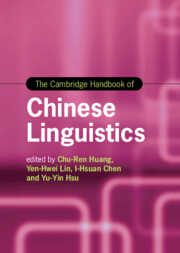Book contents
- The Cambridge Handbook of Chinese Linguistics
- Cambridge Handbooks In Language and Linguistics
- The Cambridge Handbook of Chinese Linguistics
- Copyright page
- Contents
- Figures
- Tables
- Contributors
- Acknowledgments
- Part One Writing System/Neuro-cognitive Processing of Chinese
- Part Two Morpho-lexical Issues in Chinese
- Part Three Phonetic-phonological Issues in Chinese
- Part Four Syntax-semantics, Pragmatics, and Discourse Issues
- 19 SVO as the Canonical Word Order in Modern Chinese
- 20 SOV as the Canonical Word Order in Modern Chinese
- 21 Semantic and Pragmatic Conditions on Word Order Variation in Chinese
- 22 The Case for Case in Chinese
- 23 The Case without Case in Chinese
- 24 The Syntax of Classifiers in Mandarin Chinese
- 25 The Chinese Classifier System as a Lexical-semantic System
- 26 Syntax of Sentence-final Particles in Chinese
- 27 Sentence-final Particles
- 28 Topicalization Defined by Syntax
- 29 An Interactive Perspective on Topic Constructions in Mandarin
- 30 Grammatical Acceptability in Mandarin Chinese
- Index
- References
19 - SVO as the Canonical Word Order in Modern Chinese
from Part Four - Syntax-semantics, Pragmatics, and Discourse Issues
Published online by Cambridge University Press: 04 August 2022
- The Cambridge Handbook of Chinese Linguistics
- Cambridge Handbooks In Language and Linguistics
- The Cambridge Handbook of Chinese Linguistics
- Copyright page
- Contents
- Figures
- Tables
- Contributors
- Acknowledgments
- Part One Writing System/Neuro-cognitive Processing of Chinese
- Part Two Morpho-lexical Issues in Chinese
- Part Three Phonetic-phonological Issues in Chinese
- Part Four Syntax-semantics, Pragmatics, and Discourse Issues
- 19 SVO as the Canonical Word Order in Modern Chinese
- 20 SOV as the Canonical Word Order in Modern Chinese
- 21 Semantic and Pragmatic Conditions on Word Order Variation in Chinese
- 22 The Case for Case in Chinese
- 23 The Case without Case in Chinese
- 24 The Syntax of Classifiers in Mandarin Chinese
- 25 The Chinese Classifier System as a Lexical-semantic System
- 26 Syntax of Sentence-final Particles in Chinese
- 27 Sentence-final Particles
- 28 Topicalization Defined by Syntax
- 29 An Interactive Perspective on Topic Constructions in Mandarin
- 30 Grammatical Acceptability in Mandarin Chinese
- Index
- References
Summary
The question of what canonical word order Chinese has is not a controversial issue at the present time; most of the studies within the last 30 years assume that the canonical word order of Modern Chinese is SVO. However, during the 1970s and 80s there was a lively debate on Chinese word order concerning its historical development as well as its status in Modern Chinese. This chapter reviews the arguments for and against SVO as the canonical word order in Chinese. Arguments for SVO originated as reactions against two claims: Chinese is in the process of becoming an SOV language, and Modern Chinese is an SOV language. A wide range of arguments have been brought forth to argue against the two claims, including historical development, grammar internal considerations, typological features, and discourse analysis.
- Type
- Chapter
- Information
- The Cambridge Handbook of Chinese Linguistics , pp. 407 - 427Publisher: Cambridge University PressPrint publication year: 2022

